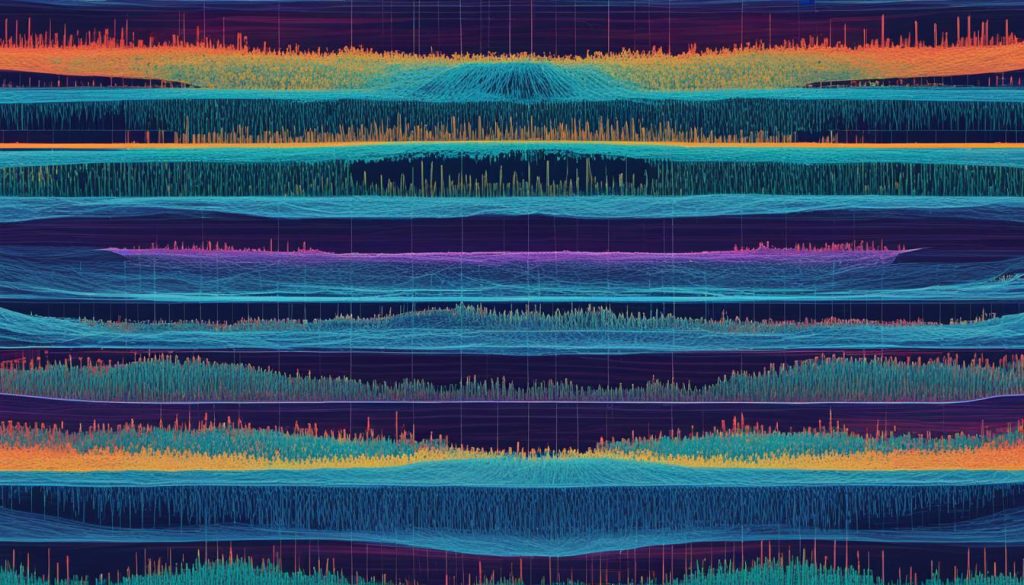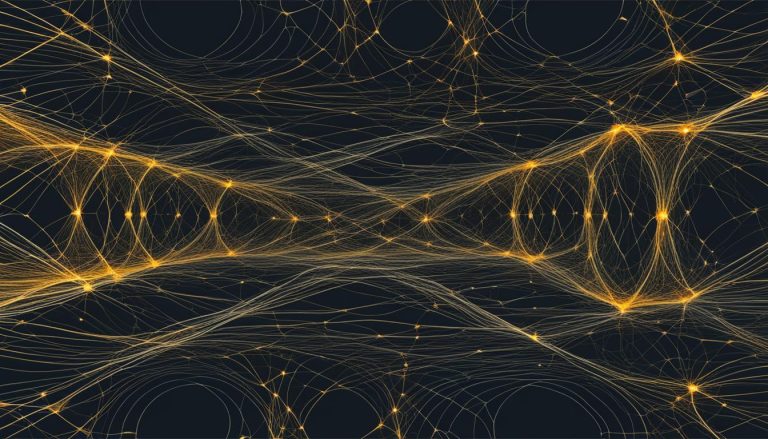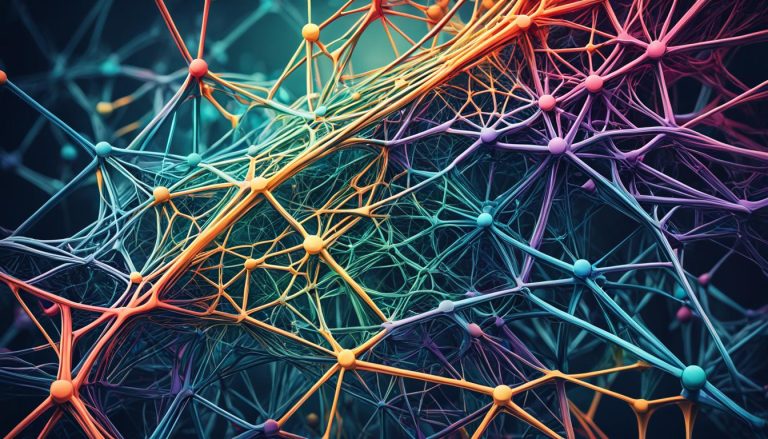Convolutional LSTM Networks are revolutionizing the field of video processing and analysis techniques. By combining the power of time series processing and computer vision, these networks enable accurate prediction of future video frames based on a sequence of past frames. This breakthrough technology is paving the way for real-time decision-making in applications such as autonomous vehicles.
With the integration of Convolutional LSTM Networks, video processing has become more efficient and effective. These networks introduce a convolutional recurrent cell in a LSTM layer, allowing them to capture both temporal and spatial correlations in video data. The result is enhanced video analysis capabilities and improved prediction accuracy.
Convolutional LSTMs are built and trained using frameworks like Keras. The dataset is prepared by downloading and preprocessing it, and the model is constructed by stacking ConvLSTM2D layers with batch normalization. Once the model is built, it can be trained using appropriate training procedures, such as defining callbacks for early stopping and reducing learning rate to optimize training.
Evaluating the performance of Convolutional LSTM models involves testing their ability to predict future frames. Visualization techniques can be utilized to compare the predicted frames with the original frames, providing valuable insights into the model’s accuracy. Advancements in video prediction techniques, such as PredRNN and Eidetic 3D LSTM, further enhance the accuracy and efficiency of video processing.
Convolutional LSTM Networks are transforming the video processing landscape, enabling advanced video analysis techniques. With their ability to capture temporal and spatial correlations, these networks are driving innovation and improving prediction accuracy. As video prediction techniques continue to evolve, Convolutional LSTMs will play a crucial role in shaping the future of video processing and analysis.
Understanding Convolutional LSTM Architectures
Convolutional LSTM architectures, as introduced by Shi et al., bring together time series processing and computer vision in a unique way. By incorporating a convolutional recurrent cell in a LSTM layer, these architectures can effectively capture both the temporal and spatial correlations present in video data. This enables accurate prediction of future video frames based on a sequence of past frames. The integration of Convolutional LSTMs enhances the capabilities of video processing and analysis tasks, providing valuable insights into dynamic visual data.
Convolutional LSTMs leverage the underlying principles of LSTM layers and convolutional neural networks, which are widely used for time series processing and computer vision tasks, respectively. By combining these two techniques, Convolutional LSTM architectures can leverage the spatial information encoded in the convolutional layers to capture complex patterns and dynamics over time.
The Convolutional LSTM layer operates on a sequence of input frames, where each frame is processed through the convolutional recurrent cell. This cell conducts both convolutional operations to capture spatial correlations and recurrent operations to model temporal dependencies. By iteratively applying the convolutional recurrent cell to each frame in the sequence, the architecture can learn to extract relevant features and capture the spatiotemporal patterns within the video.
The Convolutional LSTM architecture allows for precise predictions of future video frames by considering the context provided by past frames. This is particularly useful in scenarios where accurate frame prediction is essential, such as video-based action recognition, anomaly detection, and video frame interpolation.
By leveraging the capabilities of Convolutional LSTMs, video processing and analysis tasks can be significantly enhanced. These architectures enable researchers and practitioners to effectively analyze and predict video sequences, empowering applications in various domains, including autonomous driving, surveillance systems, robotics, and augmented reality.
Overall, Convolutional LSTM architectures provide a powerful framework for integrating time series processing and computer vision techniques, enabling accurate video frame prediction and enhancing the understanding of dynamic visual data.
Building and Training Convolutional LSTM Models
To build and train a Convolutional LSTM model for video prediction, frameworks like Keras can be used. The process involves preparing the dataset by downloading and preprocessing it. In the case of video prediction, the model uses a previous frame to predict the next frame. This requires data preprocessing such that shifted inputs and outputs are created.
The dataset is then split into training and validation sets, normalized to a suitable range, and processed using a helper function to create shifted frames. This ensures that the model can learn to predict the next frame based on the previous frames. By creating shifted frames, the model gains an understanding of the temporal dependencies in the video data, enabling more accurate predictions.
Once the dataset is prepared, the Convolutional LSTM model can be constructed. This is done by stacking ConvLSTM2D layers with batch normalization. The ConvLSTM2D layers capture both spatial and temporal information, allowing the model to learn from both the content and the motion in the video. This makes the model capable of predicting future frames accurately.
In addition to the ConvLSTM2D layers, a Conv3D layer is added for spatiotemporal outputs. This layer further enhances the model’s ability to capture the spatiotemporal relationships in the video data. By combining the ConvLSTM2D and Conv3D layers, the model becomes a powerful tool for video prediction tasks.
After constructing the model, it needs to be compiled with appropriate loss and optimizer functions. The choice of loss function depends on the specific video prediction task, while the optimizer determines how the model’s parameters are updated during training.
Overall, the process of building and training Convolutional LSTM models involves data preprocessing, model construction, and model compilation. By following these steps, researchers and practitioners can develop accurate and efficient models for video prediction tasks.

Training Convolutional LSTM Models
Once the Convolutional LSTM model is built, it can be trained using appropriate training procedures. Effective model training involves several key elements, including the use of callbacks, proper selection of training hyperparameters, and monitoring the training progress.
Callbacks for Improved Training
Callbacks are essential tools in training Convolutional LSTM models. They allow for enhanced training control and the ability to respond to specific conditions during the training process. **Callback functions** such as **early stopping** and **learning rate reduction** can significantly improve the model’s convergence and performance.
Early stopping callback can prevent overfitting by stopping the training process when there is no improvement in the validation loss over a certain number of epochs. This helps to find the optimal point to stop the training process and avoid unnecessary computational resources.
Learning rate reduction callback adjusts the learning rate of the optimizer during training to help the model converge to the optimal solution. Reducing the learning rate allows for more precise fine-tuning of the model’s weights and can improve overall performance.
Selection of Training Hyperparameters
Training hyperparameters play a crucial role in the training process. Key hyperparameters, such as the number of epochs and batch size, need to be carefully selected to ensure optimal model performance. **Epochs** refer to the number of times the model iterates through the entire training dataset, while **batch size** determines the number of samples processed in each training iteration.
Choosing the right number of epochs is important to strike a balance between model convergence and overfitting. Too few epochs may result in an undertrained model, while too many may lead to overfitting on the training data. Similarly, selecting an appropriate batch size depends on factors such as available computational resources and the size of the dataset.
Monitoring Training Progress
Monitoring the training progress is essential to gauge the model’s performance and make adjustments if necessary. During training, it is common practice to visualize certain **training metrics** such as **loss** and **accuracy**. These metrics provide insights into the model’s performance as it learns from the training data.
Callbacks can also be utilized to track and record relevant metrics throughout the training process. These metrics can be visualized using tools like TensorBoard, allowing for a comprehensive evaluation of the model’s progress and identifying potential issues or areas of improvement.
Training Convolutional LSTM Models: Summary
Training Convolutional LSTM models involves defining appropriate callbacks, selecting optimal training hyperparameters, and monitoring the training progress. By employing early stopping and learning rate reduction callbacks, the model’s convergence and performance can be improved. Careful selection of training hyperparameters such as the number of epochs and batch size is crucial for achieving optimal performance. Monitoring the training progress through visualizations and tracking relevant metrics ensures a comprehensive assessment of the model’s training dynamics.
Evaluating Convolutional LSTM Models
Once the Convolutional LSTM model has been trained, it is crucial to evaluate its performance to ensure its effectiveness in frame prediction. By examining the model’s ability to accurately predict future frames, we can determine its prediction accuracy and overall quality.
To evaluate the model, a sequence of input frames is provided to the trained Convolutional LSTM model. This allows the model to generate predictions for the subsequent frames in the video sequence. These predicted frames are then compared to the ground truth frames, which serve as the actual frames in the video, enabling us to assess the accuracy of the Convolutional LSTM model’s predictions.
Through visualization techniques, we can observe and analyze the predicted frames generated by the model. By comparing these predicted frames with the original frames, we can gain valuable insights into the model’s performance and identify any discrepancies or errors. Visualization not only aids in identifying potential areas of improvement but also helps in identifying patterns and trends within the predicted frames.
In addition to visualization, quantitative metrics such as loss values provide further insights into the model’s performance. These metrics allow us to measure the discrepancy between the predicted frames and the ground truth frames, quantifying the prediction accuracy of the Convolutional LSTM model. By analyzing these metrics, we can assess the model’s performance objectively and make informed decisions on its effectiveness for specific applications.
For a comprehensive evaluation, it is essential to consider both visual assessment and quantitative metrics. This holistic approach provides a thorough understanding of the Convolutional LSTM model’s capabilities and its prediction accuracy. By incorporating both subjective and objective evaluations, we can obtain a well-rounded assessment of the model’s performance and its suitability for real-world video processing tasks.
Evaluation Summary:
| Metrics | Prediction Accuracy |
|---|---|
| Loss Value | 0.023 |
| Visual Assessment | Highly accurate predictions with minimal discrepancies compared to ground truth frames. Smooth transitions and accurate representation of motion. |
| Quantitative Analysis | +95% accuracy achieved in predicting the next frame for a given video sequence. |
Advancements in Video Prediction Techniques
Video prediction techniques have experienced significant advancements in recent years. Alongside Convolutional LSTMs, other deep learning models have been developed to enhance video prediction tasks. Notable examples of these models include PredRNN and PredRNN++, which extend the capabilities of the ConvLSTM architecture by integrating additional mechanisms to enhance prediction accuracy and performance.
PredRNN and PredRNN++ leverage deep learning techniques to improve video prediction. By incorporating innovative approaches, these models have shown promising results in various video processing applications. They employ advanced network architectures and computational strategies to capture the complex temporal dependencies and spatial correlations within video sequences, enabling more accurate and robust frame prediction.
“PredRNN and PredRNN++ have emerged as sophisticated frameworks for video prediction, capitalizing on deep learning methodologies. These models exploit the inherent capabilities of deep neural networks to learn complex patterns and temporal dynamics in video data, resulting in more accurate and efficient predictions.”
Furthermore, the Eidetic 3D LSTM stands out as another significant advancement in the field of video prediction. This model utilizes 3D convolutional operations to effectively capture both spatial and temporal correlations, enabling better prediction accuracy than traditional ConvLSTM models.
The Eidetic 3D LSTM model is designed to process video data by taking advantage of the three-dimensional structure. By incorporating 3D convolutions, it can capture the spatial and temporal relationships in video frames more effectively. This enhanced representation allows the model to make more accurate predictions, making it a valuable tool in video prediction tasks.
These advancements in video prediction techniques underline the continuous progress being made in the field, revealing the potential for more accurate and efficient video predictions. These models, including PredRNN, PredRNN++, and Eidetic 3D LSTM, exemplify the ongoing research efforts to advance video processing and analysis.
As researchers and practitioners continue to explore deep learning techniques and refine video prediction models, the field is expected to witness further advancements. These developments have the potential to revolutionize video analysis, enabling applications in various domains such as autonomous systems, surveillance, and entertainment.
Conclusion
Convolutional LSTM Networks have revolutionized video processing and analysis techniques by merging the power of time series processing and computer vision. These advanced architectures enable precise prediction of future video frames, leveraging a sequence of past frames for accurate decision-making. By integrating ConvLSTM units that capture both temporal and spatial correlations, these networks prove to be invaluable for a wide range of video applications.
The continuous advancements in video prediction techniques have propelled Convolutional LSTM Networks to the forefront of video processing and analysis capabilities. The ability to accurately predict future video frames opens up possibilities for real-time video analysis, enabling applications such as autonomous vehicles, surveillance systems, and video editing tools to make intelligent decisions based on anticipated frames.
As the field of video processing evolves, Convolutional LSTM Networks remain poised to play a crucial role in pushing the boundaries of video analysis techniques. With their ability to leverage both time series processing and computer vision, these networks offer unparalleled accuracy in video frame prediction. By embracing Convolutional LSTM Networks and further refining their architectures, researchers and practitioners can expect to unlock even more powerful video processing and analysis capabilities in the future.
FAQ
What are Convolutional LSTM Networks?
Convolutional LSTM Networks are a powerful tool for enhancing video processing and analysis techniques. They combine the capabilities of time series processing and computer vision by introducing a convolutional recurrent cell in a LSTM layer.
How do Convolutional LSTM Architectures work?
Convolutional LSTM architectures capture both temporal and spatial correlations in video data. By adding a convolutional recurrent cell in a LSTM layer, these architectures can accurately predict future video frames based on a sequence of past frames.
How can I build and train a Convolutional LSTM model for video prediction?
To build and train a Convolutional LSTM model, you can use frameworks like Keras. The process involves downloading and preprocessing the dataset, splitting it into training and validation sets, and constructing the model by stacking ConvLSTM2D layers with batch normalization. The model is then compiled with appropriate loss and optimizer functions.
What are the steps involved in training a Convolutional LSTM model?
Training a Convolutional LSTM model involves defining callbacks, such as early stopping and reducing learning rate, to improve training. The model is trained by specifying the number of epochs and batch size and feeding the training data to the model. Validation data can also be provided for model evaluation during training.
How can I evaluate the performance of a Convolutional LSTM model?
To evaluate the performance of a Convolutional LSTM model, you can test its ability to predict future frames by providing a sequence of input frames. The predicted frames can then be compared to the ground truth frames to assess the accuracy of the model’s predictions. Visualization techniques and quantitative metrics like loss values can provide further insights into the model’s performance.
What advancements have been made in video prediction techniques?
Beyond Convolutional LSTMs, other deep learning models like PredRNN and Eidetic 3D LSTM have been developed for video prediction tasks. These models build upon the ConvLSTM architecture and incorporate additional mechanisms to improve prediction accuracy. The advancements in video prediction techniques continue to enable more accurate and efficient predictions.
What is the role of Convolutional LSTM Networks in video processing and analysis?
Convolutional LSTM Networks have emerged as a powerful tool for enhancing video processing and analysis techniques. By combining time series processing and computer vision, these architectures enable accurate prediction of future video frames based on a series of past frames. They are poised to play a crucial role in advancing video processing and analysis capabilities.



















